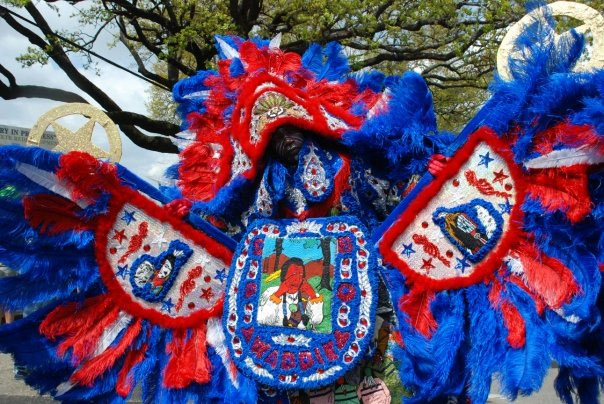Mardi Gras Indians seek to put copyrights on their costumes (original) (raw)
Chief Howard Miller knows cameras will start clicking next month when his Creole Wild West Mardi Gras Indians take to the streets with their elaborately beaded and feathered costumes.

Mary Foster / Associated Press
NEWORLEANS- Chief Howard Miller knows cameras will startclicking next month when his Creole Wild West Mardi Gras Indianstake to the streets with their elaborately beaded and featheredcostumes.
Now they and members of the city's other tribes are working toget a slice of the profits when photos of the towering outfits theyhave spent the year crafting end up in books and on posters andT-shirts.
'It's not about people taking pictures for themselves, but alot of times people take pictures and sell them,' Miller said.
'For years people have been reaping the benefits from the picturesthey take of the Mardi Gras Indians.'
Intellectual property law dating back to the nation's foundingdictates that apparel and costumes cannot be copyrighted, butTulane University adjunct law professor Ashlye Keaton has found away around that by classifying them as something else.
'Their suits and crowns, their regalia, are certainly uniqueworks of art,' Keaton said. 'They are entitled to protect thatart work.'
Keaton got to know many of the Indians through another Tulaneprogram, the Entertainment Law Legal Assistance Project.
She was intrigued by their art, more so after she saw photossold at the New Orleans Jazz and Heritage Festival and at localgalleries, apparently without their permission. Pictures of theIndians sell online for up to $500 each, and books and T-shirts arealso available.
The first test for the Indians who have copyrighted the newcostumes they will wear this year will come at Mardi Gras. TheIndians revamp or completely remake their suits every year, and thecopyright takes effect at the first public showing, said RyanVacca, an assistant professor of law at the University of AkronSchool of Law.
Keaton started working this past year with the club members tohelp preserve intellectual rights to their costumes.
Once the costumes are copyrighted, which can be done online for$40, the Indians can either sue people who sell photos of them ortry to negotiate licensing fees with photographers either before orafter the pictures are taken.
'They would be in a good position to negotiate a flat fee orpercentage of the sale, something like that,' said Vacca said.
Andrew Langsam, a New York lawyer who has been practicingintellectual property law for more than 30 years, also suggestedthe Indians find a way to notify photographers their costumes werecopyrighted -- perhaps carrying a sign saying so -- and try to find away to negotiate use of their images before hand.
The Mardi Gras Indians have a long and colorful history in NewOrleans. Since the end of the 19th century, black men have beenmaking their own version of Indian dress and banding together forinformal street parading at Mardi Gras. Local lore holds thetradition sprouted from runaway slaves' admiration for NativeAmericans who harbored them from slave hunters before the CivilWar.
Mostly the Mardi Gras Indians come from working-classneighborhoods, so their costume investment can take up much oftheir disposable income.
There is no accurate count of the groups, but about 35 arebelieved active, many with colorful names such as the WildTchoupitoulas, Black Seminoles, Fi-Yi-Yi, 7th Ward Hard HeadHunters and Creole Osceola. Each is led by a chief.
Each Indian makes a new suit every year, and over the decadesthey have become much more glitzy and elaborate. Some costthousands of dollars.
'It takes the whole year to get ready for Mardi Gras,' Millersaid. 'I can't tell you how many hours I put in.'
Miller copyrighted his costume at Keaton's urging, but it'sunclear how many other Mardi Gras Indians have, since the processhas only recently been available online and tracking the oldapplications is difficult. Miller said he expects many more Indiansto copyright their work now that several have done it and canprovide help.
He hopes having the copyright will be enough and he will be ableto negotiate with photographers and others using his image, ratherthan sue.
'This is art, what we do,' Miller said. 'These suits costthousands of dollars and all we want is a little bit of what otherpeople make from them.'
(Copyright 2011 by The Associated Press. All Rights Reserved.)